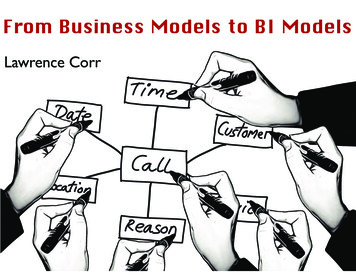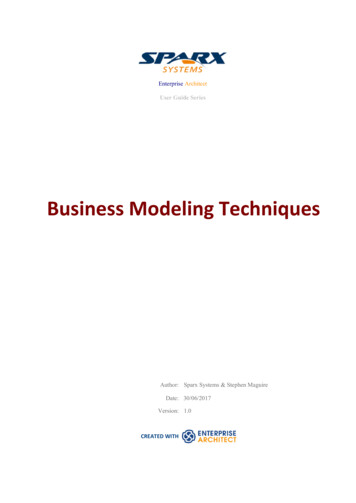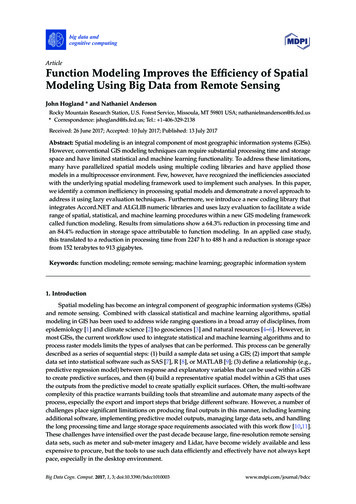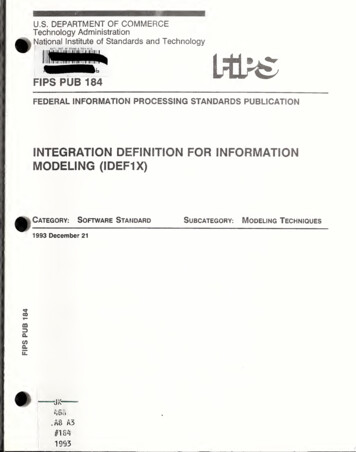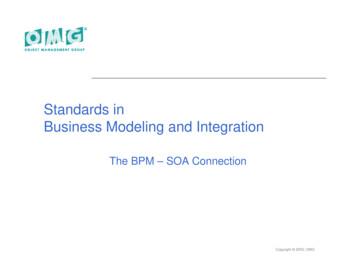
Transcription
Standards inBusiness Modeling and IntegrationThe BPM – SOA ConnectionCopyright 2005, OMG
Architecture:The Historical ProblemNonaffiliated Perimeter Network AEDI/AS2B2BWeb ServerSterling GISRogueFTPServerAffiliatesPerimeter Network BWebSphereFirst GenerationB2B GatewayFTPAS2SAPB2BNet WeaverWSHomegrown File BusinessTransfer System ConnectHTTPFTPPGPLegacy ERPB2BB2BMQSeriesConnect:DirectSecure C:MAsync/bisyncPerimeter Network iesGlobalBusinessUnitsSSLB2BAn un-orchestratedresponse tocomplexity producesapplication DCICSWebSphereApp Server Redundant andincompatible connections High maintenance whenapplications change Hodgepodge“architecture” riddledwith disconnects Information inaccessiblein timely fashion or at all Decreased ProductivityCopyright 2005, OMG
Architecture: The SOA ApproachA Service-Oriented Architectureorchestrates your current and future ITtopology at a lower TCO!Its modular design and reusablecomponents"Reduce redundancies andincompatibilities"Eliminate spaghetti"Interoperate with legacy systems!Allowing"Selective retirement at your pace"Fast response to requirement changes"Timely availability of information"Increased ProductivityApplication ServicesVisibility andManagement ServicesBusiness ProcessServicesIntegration ServicesSecurity ServicesService OrientedArchitecture FoundationCopyright 2005, OMG
Architecture: The SOA ApproachThe integration of heterogeneous services in an SOA isenhanced through the use of open standards!XML Schema Definition (XSD)!XML Path Language (XPath)!Universal Description, Discovery, Integration (UDDI)!Web Services Interoperability (WS-I)!Web Services Description Language (WSDL)!Web Services Security (WS-S)!Web Services Reliable Messaging (WSRM)!Web Services Distributed Management (WSDM)!Security Assertion Markup Language (SAML)Copyright 2005, OMG
Process: The Historical ProblemEarly efforts"Enterprise Resource Planning"Enterprise Application Integration"Business Process Re-Engineering! Were one-time eventsNot adaptive to change! Driven by ITWithout input from the business! Isolated from the communityNo extension beyond the 4 wallsCopyright 2005, OMG
Process: The BPM Approach!!!!Modeling notation understood by both business and ITExecutable models that automate systems with a business focusModular, reusable and interoperable between projects and toolsIT becomes more aligned and responsive to business changesCopyright 2005, OMG
Process: The BPM ApproachThe integration of heterogeneous activities in complexprocesses is enhanced through the use of open standards!Business Motivation Model (BMM)!Semantics for Business Vocabulary and Rules (SBVR)!Business Process Modeling Notation (BPMN)!Business Process Definition Metamodel (BPDM)!Web Service Choreography Description Language (WS-CDL)!e-Business XML for Business Processes (ebXML ebBP)!Web Service Business Process Execution Language (WS-BPEL)!XML Process Description Language (XPDL)!Production Rules Representation (PRR)!Business Process Runtime Interface (BPRI)Copyright 2005, OMG
The Business Modeling andIntegration Domain Task ForceBMI’s mission is to develop specifications of integrated models thatsupport these areas of business management:!Business planning and motivation modeling!Business Process Management!Business rules!Business modeling!Business language and vocabularyThe BPMI Steering Committee educates the broader businesscommunity on BMI’s work and refines the focus of BMI effortsCopyright 2005, OMG
BMI StandardsComputation Independent ModelBMMSBVRBPMNBPDMBPRIPRRBusiness ModelPlatform Independent ModelPlatform Specific ModelModel Driven Architecture (MDA)Copyright 2005, OMG
Business ProcessModelling Notation (BPMN)Computation Independent ModelBMMSBVRBPMNBPDMBPRIPRRBusiness ModelPlatform Independent ModelPlatform Specific ModelModel Driven Architecture (MDA)Copyright 2005, OMG
Flow Notation for the Rest of Us! BPMN 1.0 originally released by BPMI in May, 2004! Designed for the business analyst, rather than the programmer! Fast-tracked by OMG. In the finalization process todaywww.omg.org/docs/dtc/06-02-01.pdf! Currently supported by more than 30 vendor toolsCopyright 2005, OMG
Business ProcessDiagram ElementsThe core set of modelingelements enable the easydevelopment simpleBusiness ProcessDiagrams that will lookfamiliar to most BusinessAnalysts (who have seenflowchart diagrams)Copyright 2005, OMG
BP Diagram Elements: Activities!An activity is workperformed within a businessprocess!An activity can be atomicor non-atomic (compound)!Types of activities" Process" Sub-Process" Task.Copyright 2005, OMG
BP Diagram Elements: Connections!A Sequence Flow is usedto show the order thatactivities will be performedin a Process!A Message Flow is usedto show the flow ofmessages between twoentities (sender andreceiver)!An Association is used tolink information and artifactswith flow objectsCopyright 2005, OMG
BP Diagram Elements: Events!An Event is somethingthat “happens” during thecourse of a businessprocess!Events affect the flow ofthe Process and usuallyhave a trigger or a result" Starting, interrupting,or ending the flowCopyright 2005, OMG
Business ProcessDefinition Metamodel (BPDM)Computation Independent ModelBMMSBVRBPMNBPDMBPRIPRRBusiness ModelPlatform Independent ModelPlatform Specific ModelModel Driven Architecture (MDA)Copyright 2005, OMG
Business ProcessDefinition Metamodel (BPDM)! BPDM is an OMG work in progresswww.omg.org/docs/bmi/05-12-01.pdf! Submission in August 2004 by six vendorsAdaptive, Borland, Data Access Technologies, EDS, IBM, 88 Solutions! BPDM is designed to provide a common semantic representationfor BPMN and a number of other process description languagesCopyright 2005, OMG
BPDM Promotes Interoperability!Provides a common BPMN serialization mechanism!Provides a common semantic for process modeling!Mappings for many standards"BPMN"OASISWS-BPEL (Business Process Execution Language)ebXML ebBP (XML for e-Business Processes)"W3CWS-CDL (Web Service Choreography Description Language)"WfMCXPDL (XML-based Process Description Language)Copyright 2005, OMG
BPDM Supported Models!Orchestration Process models"Are action-oriented. They perform transformations"Are under the exclusive control of a business entityThe workflowDefines dependencies between process parts owned by thecontrolling business entity!Collaboration Process models"Are not action-oriented. They perform communication"Are not under the exclusive control of a business entityThe workflowDefines dependencies between interfacing parts not ownedexclusively by any one of the participantsCopyright 2005, OMG
BPDM Supported ngSupplierControl ActionMessage ledgmentCopyright 2005, OMG
BPDM Workflow SemanticsProc e s sin g Be ha v io rPa rto wne rProce ssPro c e s s{whole }proce ss{whole }Se que n ceCo nne c t io n*Input Flo wincoming*{ne xt}0.1owne dAction{comp osite pa rt}Ac t io nowne dPe rforme r{comp osite pa rt}0. . 1*Pe rfo rm e rRo leAc t io n Flo w*0. . 1pe rforme dActionOut put Flo woutgoing*{pre viou s}0. . 1Be ha v io ra l P a rtCopyright 2005, OMG
Semantics forBusiness Vocabulary and RulesComputation Independent ModelBMMSBVRBPMNBPDMBPRIPRRBusiness ModelPlatform Independent ModelPlatform Specific ModelModel Driven Architecture (MDA)Copyright 2005, OMG
A Vocabulary for Business! SBVR is in OMG’s finalization processwww.omg.org/docs/dtc/05-11-01.pdf! Submitted as a response to the 2003 OMG RFPBusiness Semantics of Business Rules! SBVR is a metamodel that provides an XMI representation forbusiness rules, facts and conceptsCopyright 2005, OMG
SBVR is Fact-Based! A fact is a proposition taken to be true by the business" The business acts as if it believes the proposition is true! An existential fact simply asserts the existence of an individual" e.g. there is a Country that has the CountryCode ‘US’! An elementary fact is a declaration" Either, that an object has a property(e.g. The Country named ‘Australia’ is large)" Or, that one or more objects participate in a relationship(e.g. The Prime Minister named ‘John Howard’ was born in the Countrynamed ‘Australia’)" Where the fact cannot, without information loss, be split into simplerfacts with the same objects! Population facts are restricted to existential or elementary factsCopyright 2005, OMG
SBVR Promotes Reuse! Captures business facts and business rules that may beexpressed either informally or formally" Rules built on facts built on concepts, expressed by terms! Defines instances of the SBVR metamodel as businessvocabularies suitable for a particular organization" These vocabularies map rules, facts and concepts from their naturallanguage expression to MOF-compliant artifacts! Shared among" Other parts of an organization" An organization’s business partners! Provides structured, rigorous and consistent input for applicationand process requirements! Supports levels of rule enforcementCopyright 2005, OMG
SBVR SemanticsCommunitysharesSub-communities may usedifferent natural languagesand specializedvocabulariesusesBody of ationConcepts (including FactTypes) and Business RulesAbstract formulation ofsemanticsRepresentation of Body ofShared Meanings inBusiness VocabularyunderpinsstructuredasFormal LogicrepresentedasunderpinsFirst-Order Predicate Logicwith some (limited)extensionsCopyright 2005, OMG
SBVR Expressed in UMLCopyright 2005, OMG
Business Motivation Model (BMM)Computation Independent ModelBMMSBVRBPMNBPDMBPRIPRRBusiness ModelPlatform Independent ModelPlatform Specific ModelModel Driven Architecture (MDA)Copyright 2005, OMG
Business Motivation Model (BMM)! Adopted by OMG at their Tampa meeting in Feb 2006www.omg.org/docs/bmi/05-12-03.pdf! Used in business modeling projects the US, UK and Switzerland! Originally published by the Business Rules Group in Nov 2000! First BMM version presented to OMG in March 2004Influencera role playedactsbyasExternal ionInternal InfluencerCorporate ValueStatedResource QualityHabitUnstatedManagement PrerogativeCopyright 2005, OMG
BMM Provides Structure! Captures business strategy elements" Vision, mission, goals, objectives, tactics, influences andpolicies! Maps to relevant elements in other business models! Rules, processes and organization units! Helps to justify why a business has its business rulesand concepts! Helps to organize business plans and to monitor theireffective executionCopyright 2005, OMG
BMM SupportsRegulatory Compliance! Captures, centralizes and organizes""""Corporate and legal guidelinesBusiness policiesCorporate behavior influencersOperational risks! Audits information" Lineage" Stewardship" QualityCopyright 2005, OMG
BMM Supports Business Rules! Rules in BMM" Are actionable and followed by people" Can be broken and require enforcement mechanisms" Are not necessarily automatedPerhaps cannot be automated! A static constraint imposes a restriction on what factpopulations are possible or permitted" e.g. Each Employee was born on at most one Date.! A dynamic constraint imposes a restriction on transitionsbetween fact populations" e.g. a person’s marital status may change from single to married,but not from divorced to singleCopyright 2005, OMG
BMM Promotes Readiness! Enables the business to react to changes in theenvironment" e. g. Regulatory requirements! Provides the business to insight to determinestrategic moves" Maintain current position, withstanding threats and risks" Expand to new products/territories while retaining currentbusiness model" Create new business modelsCopyright 2005, OMG
Copyright 2005, OMG
BMI StandardsPromote InteroperabilityComputation Independent ModelBMMSBVRBPMNBPDMBPRIPRRBusiness ModelPlatform Independent ModelPlatform Specific ModelModel Driven Architecture (MDA)Copyright 2005, OMG
BPMS BPM SOA The Agile, Business-Driven ArchCopyright 2005, OMG
BPMS BPM SOA The Agile, Business-Driven Arch! Process-Driven SOA connects back-office and partners! Standards-centered approach promotes interoperability! IT TOC is minimized and market responsiveness is maximizedCopyright 2005, OMG
Copyright 2005, OMG
Rogue CRM FTP Server First Generation B2B Gateway Tibco Windows Servers MQ Series EDI/ AS2 B2B B2B WS Business Connect FTP PGP SSL FTP HTT P C:M Async/ bisync CIC S B2B Customers (Consumers) Customers (Corporate) Non-affiliated 3rd Parties Affiliates Global Business Units Government Agencies B2B Perimeter Network B Perimeter Network C WebSphere .


